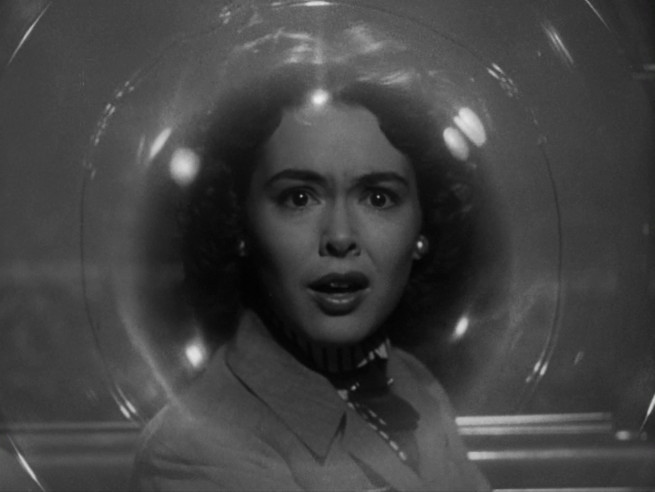To provide a reference point, 1953’s It Came From Outer Space comes off like a mix between an episode of The Twilight Zone and Star Trek, a science fiction horror tale with a message at its heart.
A prime example of the way in which horror movies transformed in the Atomic Age (the fear of nuclear annihilation on the collective consciousness throughout North America and around the world), yet with a unique twist, director Jack Arnold brings Ray Bradbury’s story (adapted into a screenplay by Harry Essex) to vivid life.
After the title explodes onto the screen, we meet amateur astronomer John Putnam (Richard Carlson – Hold That Ghost; Creature From the Black Lagoon) and his teacher girlfriend, Ellen Fields (Barbara Rush – she won Most Promising Newcomer – Female, for this film at The Golden Globes), who spot a giant meteor that hits the desert close to his home.
Investigating along with a neighbour who has a helicopter, Putnam protectively asks the pair to stay outside the crater while he checks the lay of the land. Spotting some bizarre anomalies, including an unexplainable trail of sparkling matter on the ground, it leads him to some sort of alien craft, which is buried soon after by a rockslide. Before moving on, it is worth pointing out just how effective this sequence is (which starts a bit earlier, prior to human arrival). Fusing music, setting and superb visuals, Arnold draws us in, and mystery builds in what we see and don’t see. Fog, smoke and sharp blacks are utilized as we enter the spaceship, a partial view of the alien is seen before we are treated to a first person alien perspective (a tough bubble was put around the camera lens – you will notice the sequences are usually brief, as the bubbles only lasted a short amount of time). It is the type of moment that you could just imagine a more naïve 1950’s audience screaming at in terror. It is this palpable atmosphere that pervades the entire piece.
With the spaceship being buried by the rubble, only his loving girlfriend kind of believes him, while he is ridiculed by the community, media and Sheriff, Matt Warren (Charles Drake). Soon after, Putnam and Fields spot an otherworldly being on the road one night. . . it further cementing his belief in what he saw, despite being the town laughing stock.
Other strange occurrences pop up, such as weird interference on the phone lines, baffling veteran technician Frank Daylon (Joe Sawyer) and his much younger counterpart George (Russell Johnson – the beloved Professor from Gilligan’s Island, intriguingly Jack Arnold also directed more episodes of this comedy than anyone else, 26 in total). After learning that the aliens have the ability to shapeshift into human beings that they abduct, Putnam is put in an unenviable position after he confronts them, told that they will return those taken once they have finished repairing their ship – what amounts to an accidental crash on the wrong planet. Rolling the dice, will Putnam make the right choice, saving the many community members under alien influence?
The first thing that many will notice upon watching It Came From Outer Space is its well rounded score, written by a triumvirate of talented composers – Irving Gertz, Henry Mancini, and Herman Stein. With a suspenseful orchestral background, the otherworldly theremin drives it forward, at the forefront of the deadly-alive desert mystery.
A creative story that in many ways differs from other sci-fi features of the time, the aliens are seemingly uninterested in Earth as a conquest. An undercurrent suggests that people need to work together in harmony and trust as it is of the utmost importance, rather than the xenophobic and suspicious outlook of the time.
A rare example of a fifties’ movie with end credits (similar to today), it was also released in 3-D during its initial craze (the first released by Universal-International). Its unusual alien approach is actually the main inspiration for Steven Spielberg when he made Close Encounters of the Third Kind in 1977. It was also filmed in real towns as well as in the Mojave Desert (some sound stages were used as well), adding a realistic setting for the story. It is these desert roads, Joshua trees, sandy mounds and derelict mines that play with the mind, an inhospitable land where death and destruction lies just behind those eerie mirages off in the distance. A final fascinating inside story found the make-up department developing two different alien designs. . . selecting one, the second was later used in the 1955 motion picture, This Island Earth. So, don’t wait for some other night to watch this one or you’ll miss the dynamite ending.


